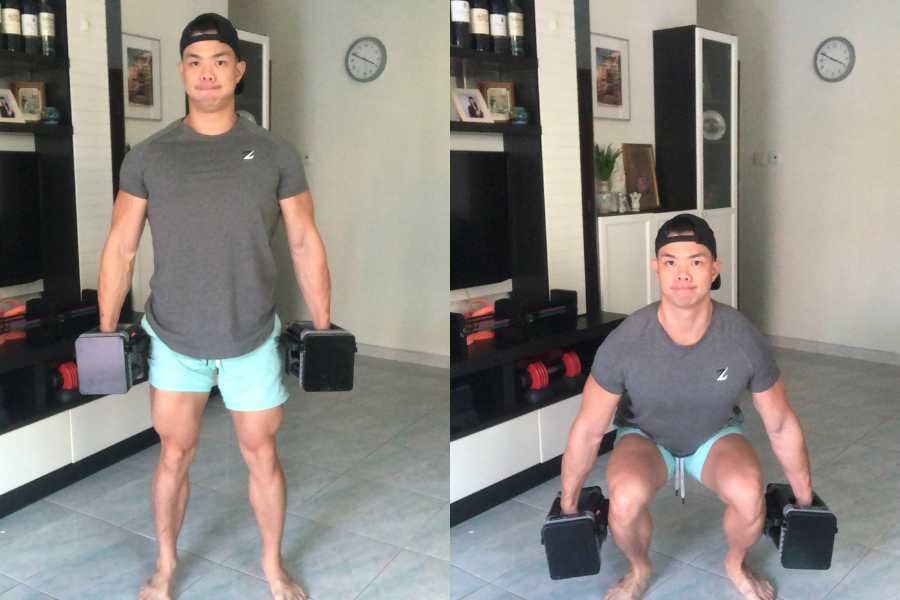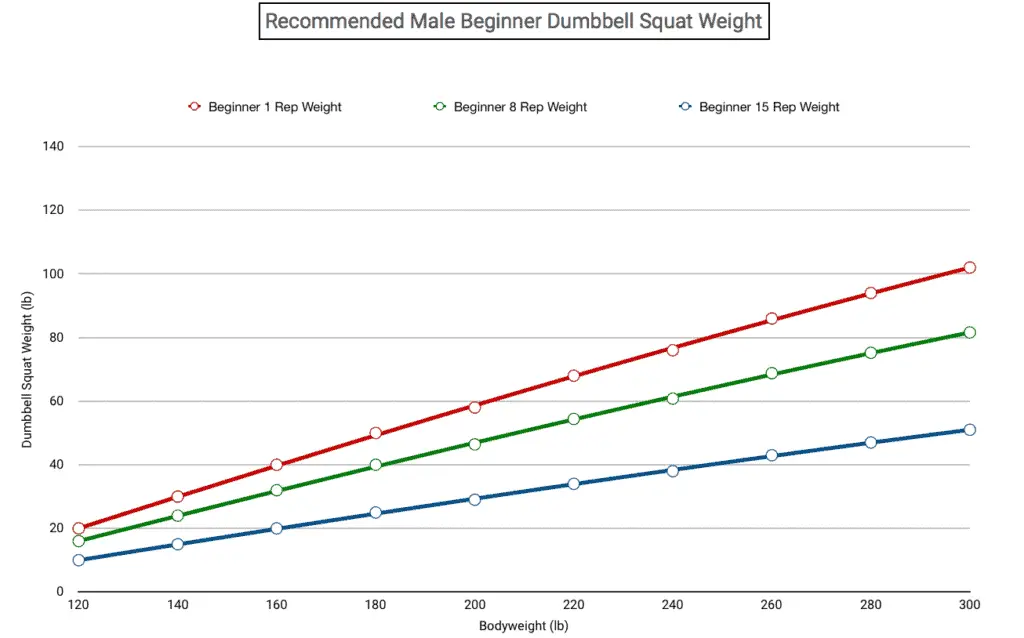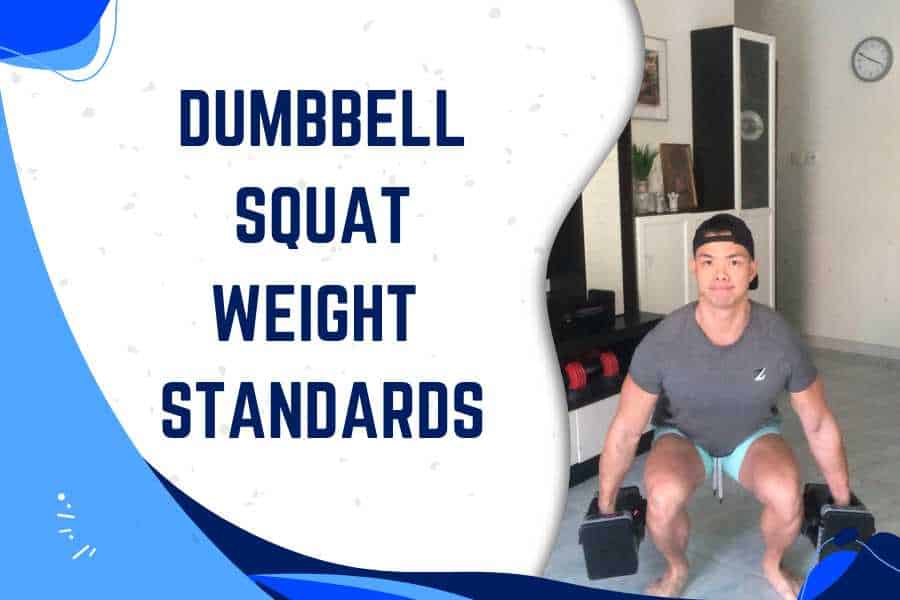Regardless of the workout you’re performing, it’s crucial to choose the correct weight for achieving the fastest muscle growth and strength gains. This post shares dumbbell squat weight standards for beginners.
Beginners should aim to dumbbell squat approximately 0.15 to 0.20x their body weight. This is a good weight to lift in the 8 to 12 rep range which is ideal for building muscle. Lighter weights should be used for higher rep ranges and vice versa.
Below, I’ll share standards based on my own training experience, reasons why you may be finding the dumbbell squat difficult, and how to increase your numbers.

How Much Beginners Should Dumbbell Squat
Squats are a great exercise for building a bigger and stronger lower body. But to gain the full benefits of squatting, it’s important to choose the right weight (see the below table).
Beginner dumbbell squat weight standards based on body weight and rep range:
| Bodyweight | Beginners 1 Rep Dumbbell Squat | Beginners 8 Rep Dumbbell Squat | Beginners 15 Rep Dumbbell Squat |
|---|---|---|---|
| 120lb | 18lb | 14lb | 9lb |
| 140lb | 27lb | 22lb | 14lb |
| 160lb | 36lb | 29lb | 18lb |
| 180lb | 44lb | 36lb | 23lb |
| 200lb | 53lb | 41lb | 26lb |
| 220lb | 61lb | 49lb | 31lb |
| 240lb | 68lb | 55lb | 34lb |
| 260lb | 77lb | 62lb | 39lb |
| 280lb | 85lb | 68lb | 42lb |
| 300lb | 92lb | 75lb | 46lb |
| Average | 56lb | 45lb | 28lb |
You’re generally considered to be a beginner if you’ve been practicing the dumbbell squat for less than 12 months.
In contrast, intermediates have trained for 12-36 months and advanced lifters have trained for 3-5 years. These individuals are usually able to squat 3x or 4x more than a beginner, respectively.
Next, here is the same beginner dumbbell squat weight standards represented as a line graph for easy visualization.

To determine how much weight you should dumbbell squat- identify your body weight and desired rep range. The line will recommend you a weight.
If you’re dumbbell squat is above these weight standards, then you’re lifting a respectable amount of weight.
Beginner Dumbbell Squat Standards As A Fraction Of Body Weight
Another way to estimate how much weight you should dumbbell squat is to take a fraction of your own body weight. This method is quick and simple.
Beginners should be able to dumbbell squat:
- 0.25x bodyweight for 1 repetition.
- 0.20x bodyweight for 8 repetitions.
- 0.15x body weight for 12 repetitions.
For example- a 150lb beginner should aim for a 30lb dumbbell squat (2x 15lb dumbbells) at 8 reps (150lbs x 0.20).
Using this method, we can conclude that the average person weighing between 150-200lbs should be dumbbell squatting a total of 22.5-50lbs (11-25lb dumbbells per hand).
What’s Considered To Be A Heavy Dumbbell Squat?
Generally speaking, a heavy weight is defined as being over 70% of your 1-rep max.
Based on this, here are the weights that are considered to be heavy for beginners to dumbbell squat:
| Bodyweight | Heavy Dumbbell Squat Weight |
|---|---|
| 120lb | 13lbs+ |
| 140lb | 19lbs+ |
| 160lb | 25lbs+ |
| 180lb | 31lbs+ |
| 200lb | 37lbs+ |
| 220lb | 43lbs+ |
| 240lb | 48lbs+ |
| 260lb | 54lbs+ |
| 280lb | 60lbs+ |
| 300lb | 66lbs+ |
| Average | 40lbs+ |
So if you’re a beginner and your dumbbell squat is close to or more than these weights, then you’re lifting a “heavy weight”.
Common Reasons Your Squat Is Below Average
The legs (hamstrings and calves in particular) can be quite difficult muscles to grow.
Here are the most common reasons leading to a weak or below-average dumbbell squat:
1) Overtraining And Undertraining
Squatting too much or too little can be detrimental to increasing your numbers.
The former can lead to overtraining, impaired muscle recovery, and stunted strength progression. The latter can result in undertraining, where your legs do not get the adequate stimulation required for optimal growth.
Amongst other factors, building bigger and stronger muscles requires the correct training frequency to be applied.
I recommend beginners perform 2-3 intense squat sessions per week. And avoid squatting every day thinking it will maximize strength gains. It doesn’t and most likely will lead to overtraining!
2) Insufficient Time Spent Practicing The Exercise
Muscle growth does not happen overnight.
As a beginner, it can take many weeks of practicing the dumbbell squat before you notice the first signs of strength gain. Likewise, it may take months to see visible muscle gain.
So be patient, train consistently, and apply progressive overload by increasing weight when you can.
This, combined with a good nutrition plan, should see your dumbbell squat increase.
3) Lifting With Poor Form And Technique
Executing the dumbbell squat with bad form can limit the weight you’re able to lift.
Examples of bad form practices that should be avoided when dumbbell squatting:
- Rounded back. It should be kept straight, angled 45° forward, and never rounded.
- Leaning forward too much. This is a starting cue for the dumbbell deadlift, but it should be avoided in the dumbbell squat where it can cause you to become imbalanced. Holding the dumbbell next to your legs and ensuring it travels in a straight vertical path can help balance your center of gravity.
- Insufficient squat depth. Thighs should reach parallel to the floor at the bottom of the squat to achieve full muscle activation.
- Inward caving knees. Actively push your knees outward to prevent them from caving in which can reduce power transduction from your legs to the dumbbell.
- Unstable feet. Keep your heels and toes planted on the floor at all times for maximal stability.
- Overly narrow stance. This takes tension away from the glutes and hamstrings and focuses it on the quads. Utilizing all of the leg muscles will help you to squat more weight.
4) Weak Target Muscles
The dumbbell squat primarily works the quads, hamstrings, glutes, calves, lower back, and shoulders.
Therefore weakness in any of these muscles can limit the amount of weight you’re able to lift.
The simplest way to overcome this is to simply practice dumbbell squats for longer. You’ll naturally get stronger and the exercise will become easier over time, allowing you to add more weight.
An alternative is to train the target muscles with other squatting variations, isolation-type leg exercises like quad extensions, and deltoid exercises to strengthen the shoulders.
5) Poor Nutrition
All the squats in the world won’t help your leg to grow if you aren’t eating enough calories and protein (essential for fuelling muscle growth).
I recommend going on a mild bulk in conjunction with your squat training.
This can ensure you build muscle and get stronger from your workouts.
For more details on how to bulk up, you can check out my guide on gaining lean mass fast.
Other Weight Standards For Dumbbell Squat Muscles
The dumbbell squat is primarily a lower-body exercise that works the quads, hamstrings, calves, and glutes. Here are weight standards for other exercises that hit similar muscle groups:
- Goblet squat– another dumbbell squat variation for targeting the quads.
- Dumbbell deadlift– full-body exercise that emphasizes the lower back, hamstrings, and glutes.
Conclusion
I’ve shared my dumbbell squat weight standards for beginners.
If you’re lifting these standards (or more), then you’re doing a respectable job.
but if you’re finding the dumbbell squat difficult and lifting sub-average numbers, then you can use my tips to help increase your numbers!
You may also be interested in the downloadable Kalibre Blueprint PDF which details exactly how I gained 40lbs of lean muscle (it’s 100% free!). It details the exact exercises and nutrition (with printables) I used to go from skinny to ripped!


